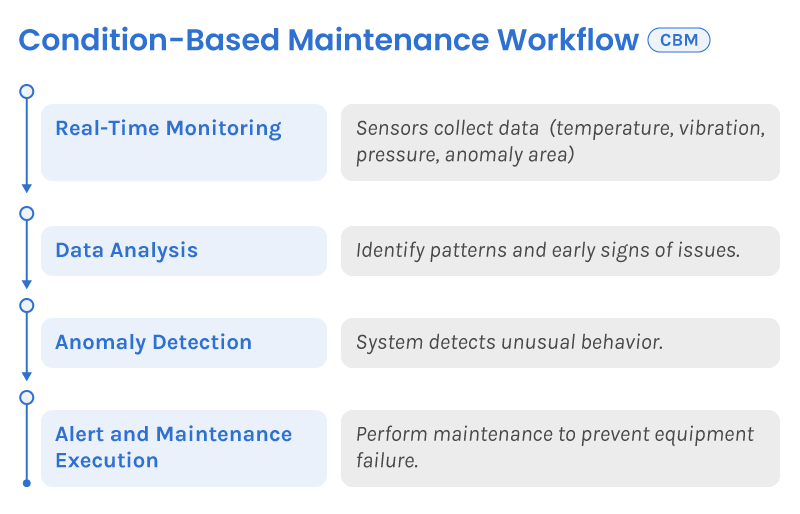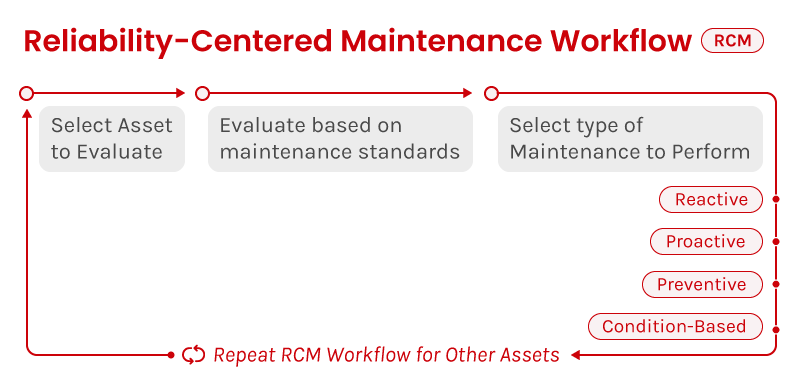Condition-Based Maintenance and Reliability-Centered Maintenance are both popular and often confused concepts in Asset Integrity Management. Indeed, they share some common goals: minimizing downtime, reducing maintenance costs, and ensuring the reliability of critical assets. However, understanding the distinctions between these two approaches is crucial for any industry looking to optimize maintenance strategies.
Condition-Based Maintenance (CBM)
Condition-Based Maintenance consists of a predictive maintenance approach that analyzes the historical performance data of machines to forecast when one is likely to fail, limit the time it is out of service, and identify the root cause of the problem. The idea here is straightforward: instead of performing maintenance on a set schedule, the equipment’s condition is monitored in real-time, and maintenance is only conducted when indicators suggest that something might go wrong.
The fundamental principle of CBM is that maintenance should only be performed when an anomaly could lead to equipment failure. It works by monitoring equipment performance through sensors and images, which collect real-time data like temperature, vibration, anomaly area, or pressure. This data is analyzed to spot patterns or early signs of issues. When the system detects unusual behavior, it signals that maintenance should be performed to prevent a breakdown.
In this regard, CBM is reducing costs by avoiding unnecessary maintenance and enabling activities to be scheduled more efficiently. According to the article ‘’On condition-based maintenance policy’’, annual savings from widespread deployment of CBM strategies in the United States alone is estimated at $35 billion.

Reliability-Centered Maintenance (RCM)
On the other hand, Reliability-Centered Maintenance expands the scope beyond predictive maintenance strategies. RCM is a comprehensive approach that considers the overall operational context, including the criticality of each asset, and the specific functions that each piece of equipment is expected to perform.
This method takes a broader, more strategic approach, aiming to identify the most efficient strategies for each specific piece of equipment. Thus, this approach considers not only the condition of the assets but also their function within the broader system, the consequences of their failure, and the criticality of the operation. The article ‘’Condition-Based Monitoring and Maintenance: State of the Art Review’’ proposed that Reliability-Centered Maintenance policies differ from CBM by focusing on continuously monitoring industrial facilities subject to inadequate maintenance.
In this sense, RCM aims to develop a maintenance agenda that prioritizes critical assets and defines what maintenance approach to adopt. Thus, it ensures that maintenance resources are allocated in the most effective way possible, helping organizations maintain higher levels of operational reliability and safety without incurring unnecessary costs. Additionally, RCM assesses risk management by providing insights on the outcomes of equipment failure and prioritizing maintenance activities that prevent high-risk consequences.

According to Plant Engineering, while 41% of industries adopt predictive methodologies to conduct maintenance, only 22% of worldwide industries use RCM as their main strategy. And, despite Predictive Maintenance being widely adopted, approximately only half of these businesses are leveraging the opportunities that RCM provides. In this context, understanding these distinctions is crucial to defining which maintenance strategy is the most adequate for different operations.
Which one to choose?
The choice between Condition-Based Maintenance (CBM) and Reliability-Centered Maintenance (RCM) depends on the specific operational requirements and objectives of an organization. CBM is well-suited for organizations aiming to minimize unnecessary maintenance tasks and prolong equipment life by leveraging real-time data. It is most effective in environments where continuous monitoring is feasible, and predictive insights can enable timely interventions, thereby reducing unplanned downtime.
Essentially, CBM is about when to perform maintenance, based on the condition of specific equipment. It’s a targeted, data-driven approach. RCM, on the other hand, is about what maintenance strategy to use, considering the bigger picture of the entire operation. It’s a broader process that could even include CBM as one of its tactics. In this manner, RCM provides a more comprehensive, risk-based strategy that takes into account not only the condition of assets but also their criticality within the broader operational framework.
Thus, while Condition-Based Maintenance (CBM) and Reliability-Centered Maintenance (RCM) both aim to optimize asset maintenance, they do so from different perspectives. CBM focuses on the condition of individual components to determine the timing of maintenance, ensuring that interventions are made when necessary based on real-time data. In contrast, RCM considers the overall system, the criticality of assets, and the potential consequences of failures to determine the most appropriate maintenance strategy.

